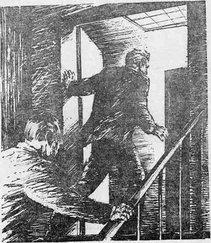* * *
Thule Operations showed Air Force three-six-zero due out at 0830 hours, bound for Andrews Air Force Base, Maryland. The crew met an hour earlier in Operations to take care of the necessary paperwork, pre-flight briefings, and the other formalities of departure. When the routine chores had been done, and the weather maps had been examined, General Miller reached into his pocket and extracted a coin. He flipped it into the air. “Call,” he said.
“Heads,” Ferguson responded.
The general looked. “Heads it is.” He addressed the NCOIC. “The pilot will be Lieutenant Ferguson. I’ll fly copilot. You have the rest.”
“Yes, sir, the crew list is ready for signature.”
Ferguson stepped up and put his name on the bottom of the form. As he finished, Sergeant Feinberg came in. “The bird is ready,” he reported. Presently, he spoke to Ferguson privately. “Did you win the toss, sir?” he asked.
“Now look, Perry, there’s no way you could have fixed that!”
The impressive sergeant gave a confident gesture. “Of course not, Lieutenant, no way at all. But I did take the liberty of mentioning to the general the sporting idea of letting the fates decide, as it were. That at least would give you a fifty percent chance. The general is well known as a sportsman and I suspected that he might go for it.”
The operations clerk was lettering Ferguson’s name on the board in the column marked PILOT. Lieutenant Jenkins handed in his flight plan; Andy Holcomb was right behind him with the weight-and-balance sheet, which already bore Sergeant Stover’s signature.
“Since we’ve got some headwinds along the route,” General Miller said, “let’s go as soon as we’re ready.”
“We’re ready now,” Ferguson answered.
The Penguin stood on the ramp just outside. The ground-support personnel were ready with the fire extinguisher, battery cart, and other required equipment. It took ten minutes to get everyone settled in and the pre-engine-start checklist run through. All was well. With practiced efficiency Ferguson fired up and waited while the engines settled in. Then he called ground control and got clearance to the run-up area. He taxied slowly and carefully until he was in position, then he set the brake firmly and went through the routine of checking all four engines and propellers and all eight magnetos. With that behind him he called the tower and advised that he was ready for takeoff.
The tower came back with immediate clearance and supplied the latest altimeter setting. There had been no change since they had left the ramp.
Ferguson advanced the throttles and guided the four-engined Boeing bomber into position on the end of the runway. Before her was 10,000 feet of runway and the unlimited sky overhead. He pressed the intercom button. “Your takeoff, sir,” he said.
Miller flashed him an appreciative smile. “I’ll try to keep her off the ice cap this time,” he said.
The engines picked up in tempo and then combined into a respectable roar. The plane began to roll forward, gaining speed. After only a short distance, the tail came off the ground and the weight rested on the main gear. The speed continued to build as the 2,000-foot marker went past. Then, gracefully as always, The Passionate Penguin lifted off the ground apparently of her own will. As she climbed up, her landing gear slowly disappeared and the wing flaps came up. Ferguson called departure control as the general turned the aircraft southward.
She climbed upward at a steady pace, her engines running smoothly, until those who were watching from the ground could no longer hear the sound, and the plane herself was little more than a diminishing speck in the sky.
AlC: Aircraft Commander, the pilot in charge.
ACM: Additional Crew Member, a term frequently applied to riders who have no actual function in the operation of an aircraft.
ADF: Automatic Direction Finder, a radio-navigation device that, in essence, has a needle that points directly toward the station to which it is tuned.
Advancing line search: One of several techniques for systematically searching a given area from the air.
A-frame: A simple, portable device, usually equipped with a block and tackle, which can be used for moderately heavy lifting jobs at field locations.
Aileron: A relatively small, movable control surface normally located at or near the wingtips of an aircraft. They are used to keep the wings level or to bank them while turning.
Airframe: The main structure of an aircraft, excluding the engine(s).
Airlifier: An aircraft specifically designed to carry freight. The term is sometimes applied to other aircraft that have been modified for cargo use.
Airscrew: Another, more technical, name for propeller.
Airway: A specific, frequently used flight path that is equipped with navigational aids. An air highway.
Alclad: A type of sheet metal used in aircraft construction. It consists of a strong aluminum alloy covered with a layer of pure aluminum to resist corrosion.
Altimeter: An instrument that shows the height of an aircraft above sea level. Most altimeters work by atmospheric pressure and need to be frequently reset. Radar altimeters read the distance above the ground or water directly underneath the aircraft.
Analyzer: A piece of electronic equipment which displays on a tube face a continuous report on the condition and functioning of an aircraft engine.
Angle of attack: The angle at which the wing of an aircraft meets the relative wind. Under normal flight conditions, increasing the angle of attack increases the amount of lift generated, up to a specific point.
AOK: A familiar military expression meaning “as good as possible.”
APU: Auxiliary Power Unit. On large aircraft, the APU supplies power to operate various systems while the main engines are shut down.
Archie: The Thule designation for Arctic foxes.
ARRS: Aerospace Rescue and Recovery Service, a part of the Military Airlift Command.
Artificial horizon: An aircraft instrument that, by means of a gyroscope, can display on its face a miniature aircraft and a horizon line, which correspond to the relative positions of the actual aircraft and the true horizon.
ASAP: As Soon As Possible.
Atmospheric pressure: The almost constantly changing pressure of the atmosphere as it would be measured at sea level. The world standard for average conditions is 29.92 inches of mercury in a vacuum.
Autopilot (sometimes Automatic pilot): A piece of equipment normally capable of maintaining an aircraft’s flight path at a preset direction, altitude, and attitude. Highly sophisticated units are coupled to radar altimeters and can thereby avoid terrain obstructions when flying at low altitude.
Avionics: Electronic equipment normally used for navigational purposes.
B-17: One of the bulwarks of the United States Army Air Corps during World War II, the B-17 (B for “bomber”) was a four-engined heavy bomber, piston-powered and principally used for daylight bombing of the Axis strongholds. Thousands were built. The B-17 enjoyed a phenomenal reputation for durability; many of them flew home despite severe battle damage. The B-17 was designed and built by Boeing; when additional planes of the same type were needed, production lines were also set up at Douglas Aircraft Corporation at Vega.
Ballistic Missle Early Warning System (BMEWS): A very large, highly complicated, and extremely powerful radar installation kept in continuous operation to give warning in case of an attack launched against the United States or Canada by means of ballistic missiles.
Читать дальше












